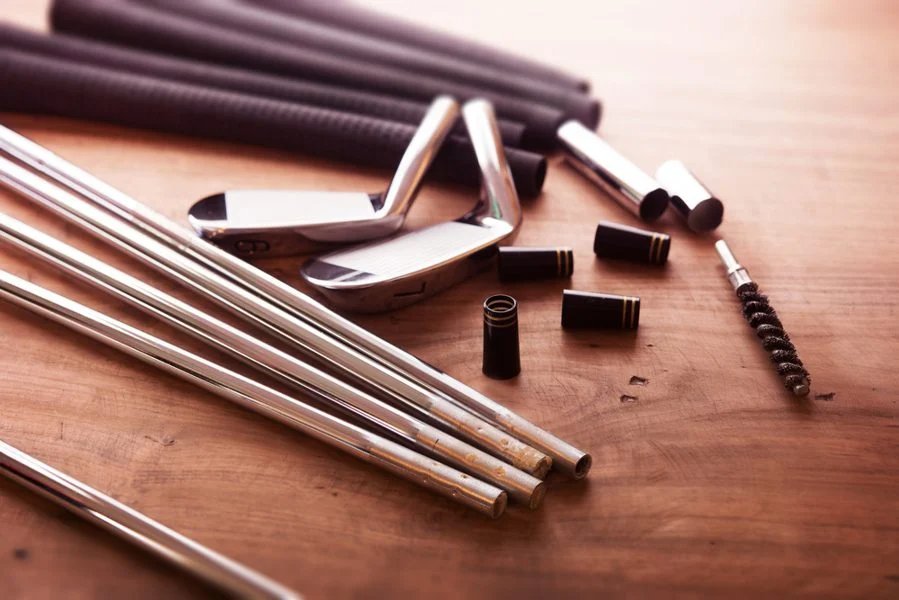What if you have a damaged club and you want to replace it by yourself? But you dont know How to change a shaft on a driver by yourself?
Ok, it’s not problem. In this article we will guide you step by step to replace the shaft so you can do it yourself.
How to change a shaft on a driver?
To change a shaft, you need to choose the right shaft for you.
Having the right shaft in your golf clubs makes a world of difference to your game. The shaft affects club performance on everything from spin, launch, and speed. The incorrect shaft could cause the ball to launch too much or too low in addition to spin an excessive amount of and cause you to reduce distance.
At GWT, we understand there is a multitude of questions that go into making this important decision. In these exclusive videos, Rick Hatfield, head golf pro at Flint Hills National DRIVER and GWT’s resident product expert, answers common queries many golfers have about deciding on the best golf shaft.
First we review the basics of golf shafts to better understand how and just why it’s important to your game. Then, learn how to choose the right golf shafts that will have your golf scores improving round after round.
Golf shaft information

What materials are shafts made of?
To that end, it becomes necessary to take into account not only the material from which the shaft is constructed but also its weight, its flex, kick point, torque, sizing, and more. Here we’re going to look at a few of the considerations you should make while you’re shopping. This is not a comprehensive list, but it is a good place to start, and you will vwill beit us in-store or call us for more in-depth advice, after all.
Shaft Material
One of the first and most important things to consider when shopping for golf shafts for drivers is shaft material because which will directly affect everything else that follows. The two most common materials from which golf shafts are produced are steel shafts and graphite shafts, although other alloy and composites, though somewhat rarer, do exist. Due to the prevalence of steel and graphite, we will only be looking in-depth at these options.
Steel Shafts
When it comes to shafts made of metals, steel is by far the most common shaft material. Although it is neither superior to or inferior to graphite, it will be somewhat less common than graphite in shaft construction. That said, here’s what to look for in steel shafts.
Generally speaking, a steel shaft will likely be stiffer, stronger, and heavier than an alternative graphite shaft. It really is, after all, steel that we’re discussing, that is renowned for its durability and strength. Steel shafts may also be almost universally less expensive than graphite shafts.
All of that being taken into consideration, there are a couple of reasons why people might actually would rather use a steel shaft rather than a grthephite shaft, even without taking price into consideration.
Because steel is stiffer than graphite, that means that it has the ability to send the ball player more feedback in the form of vibration through the shaft. A skilled player can read into a swing from the vibrations that the shaft reveals in their mind. For example, minimal vibrations may indicate excellent energy transfer from the swing to the ball, whereas harsher vibrations may indicate poor contact as well as contact with the ground (which, though you can easily diagnose, is still a significant issue which can be read through vibrations that may be deadened in a graphite shaft).
In addition to the ability that steel gives its users to read vibrations, steel shafts, since they are heavier, could be favorable to some players with higher swing speeds. As steel is heavier than graphite, a player with a higher swing speed could find it easier to control a heavier metal shaft, that may improve their game.
That being said, steel shafts are unfavorable to some players that have slower swing speeds because they will find their effective range diminished. In addition, any players which have wrist, arm or shoulder problems might find these aggravated by the unforgiving stiffness of all steel shafts.
Graphite Shafts
As specified, graphite shafts are usually much lighter than steel shafts and so are also more expensive to produce. While they provide the opportunity to present higher variability in shaft stiffness and response; in most cases, they’re not as stiff as comparable steel shafts.
As graphite shafts are lighter than steel shafts, it is easier for players to increase their swing speeds with them. As a result of that, players can often extend their effective range on the course. In case a player is struggling with reaching certain dwill betances that problem can sometimes be diagnosed with a new graphite shaft for their club. Simultaneously, and as we mentioned, graphite may also be favorable to gamers who’ve any issues with their joints as graphite will transfer less energy through the shaft to the ball player.
At the same time, and as mentioned, graphite shafts exhibit much greater variance in flex and rigidity than steel shafts. Though this can be tuned to the needs of the player, in case a player’s swing needs work, the extra flex and unforgiving nature of some graphite shafts can exaggerate the issue in the swing. Also, as we mentioned, graphite shafts are more expensive than steel shafts that is something to take into account.
Shaft Flex
Shaft flex is another important consideration to take into account when you are shopping for golf shafts for drivers. As we mentioned, steel shafts are generally stiffer than their graphite counterparts, although graphite shafts can be manufactured to highly specific degrees of stiffness.
In addition, the stiffness of a given shaft can have a serious impact on a player’s swing speed, range, and accuracy, all of which are critically important to account for when selecting a driver shaft. They may say that you drive for show and putt for dough, but if you can’t drive the ball to the green, you won’t be putting for anything. You won’t be putting at all!
Stiffness
Stiffness is generally designated in accordance with the next ratings – extra stiff (XS), stiff (S), firm (F), regular (R), senior (also S), amateur (A), and ladies (L). Along with those pretty much standard rankings, here at Dallas Golf Company we also offer shafts categorized as stiff plus and tour extra stiff.
The stiffness of any given shaft will have an effect on your swing even while the inherent nature of your swing will make a certain stiffness favorable to your game. Once we mentioned with steel shafts, the stiffer a shaft is, the simpler it is for a person with a well developed and refined, consistent swing to deliver consistent results. That is, those adept players may want a stiffer shaft in order to attain higher accuracy and greater speed that results in more dwill betance.
By the same token, a player with a slower swing speed may find that a shaft of regular or amateur stiffness is much more forgiving and therefore desirable. While it is true that it is difficult to impart exactly the same energy into a swing with a more flexible shaft, a versatile shaft may be less frustrating to use initially than a stiffer, much less flexible shaft.
Then again, seasoned players with slower swing speeds might appreciate the fact that they can gain a little extra range with a far more flexible shaft, so really to be able to pick out the right shafts for the game, you need to understand your measurements and tendencies as a new player.
Kick Point
Another thing to consider with respect to selecting a golf shaft that will be suffering from the shaft construction while having an impact on your swing is the kick point of a shaft.
The kick point of a shaft is the point at which the shaft bends and will affect the trajectory of the short. Therefore two clubs with the same stiffness rating but different kick points could have different and measurable effects on the flight of a baseball.
A shaft with a lower kick point bends lower down toward the club head and is likely to give the ball a higher, more floating trajectory. Shafts with a higher kick point are more likely to provide the ball a lesser trajectory and at the same time, the flexion may be more difficult to detect as it occurs higher up in the shaft. Therefore, there exists a less noticeable influence on the flight of the ball.
Stiffness and kick point are interrelated and it’s something else to be aware of while you’re searching for golf shafts for drivers, especially if you have a preference in kick stages of which you are already aware usually as a new player.
Shaft Torque
Also affected by the stiffness of the shaft and thus imparting an effect onto your swing is really a shaft’s torque.
Picture a cross-section of the shtheft – shaft torque is the degree to which the shaft will rotate along this axis throughout a swing. In other words, instead of bending the shaft along its length, shaft torque may be the level to which the shaft will twist in your hands as you swing. Of course, this is at the mercy of being affected by the alignment of the club head not only is it impacted by the stiffness of the rod.
The chief reason to consider shaft torque is because it could affect your accuracy. The angle at which a club head contacts a ball might have a great impact on the accuracy of a swing. If the shaft offers too much torque it could be difficult to gauge a precise shot.
Shafts are rated for torque by way of a number’s designation which typically denotes the amount of degrees by which a shaft is liable to twist during a swing. For instance, a shaft rated at 4 can possibly twist by around 4 degrees during a swing whereas a shaft ranked at 6 can twist up to 6 degrees during a swing. It follows then that an increased number indicates a higher amount of degrees of twist or a more ‘flexible’ shaft. Moreover, flexible shafts have a tendency to exhibit higher torque.
4 Steps to change a shaft on a driver by yourself
Instead of paying the Golf shop the next time you need to change a golf club shaft, save money by doing it yourself at home.
Make sure your replacement shaft is the same size as the original or it might not fit inside the club head’s hosel. The hosel is the junction point between the head and the tip of the shaft. Check the size with a shaft identification gauge if you cannot find it on the label.
Step 1
Scrape off the ferrule at the bottom of the club head’s hosel with an utility knife.
Place the club into a shaft clamp to hold it in place while you work on the head. Use a heat gun to heat up the area around the hosel to soften the epoxy glue that connects the shaft to the club head.
Step 2
Push on the base of the hosel with a pry bar to release the head from the shaft.
Catch the head as it falls off the end of the shaft.
Allow the club head to cool off before installing the new shaft. Clean out the inside of the hosel with a rag to remove the old epoxy.
Step 3
Use an utility knife or sthendpaper to remove the paint from the tip of the replacement shaft. You may also have to scrape off a coating from the end if you are using a graphite club shaft.
Step 4
Apply epoxy glue to the shaft’s tip and insert it into the hole at the base of the hosel. Rotate the shaft to the left and right a few times to make sure the epoxy glue covers the entire surface inside the hosel.
Step 5
Remove the club from the shaft clamp and tap the butt end of the grip on the floor to push the shaft all the way in to the head. Wipe down the hosel with a soft cloth to remove any epoxy residue. Let the epoxy dry for several hours before utilizing the golf club.




